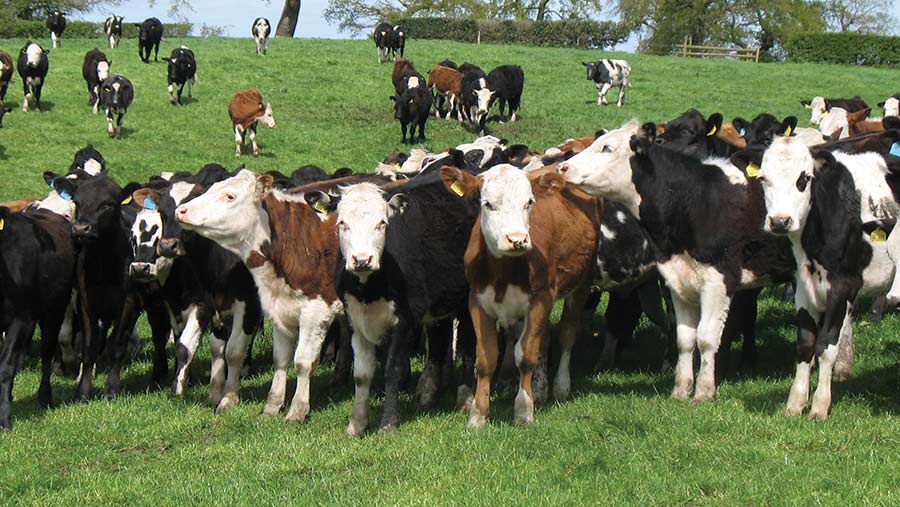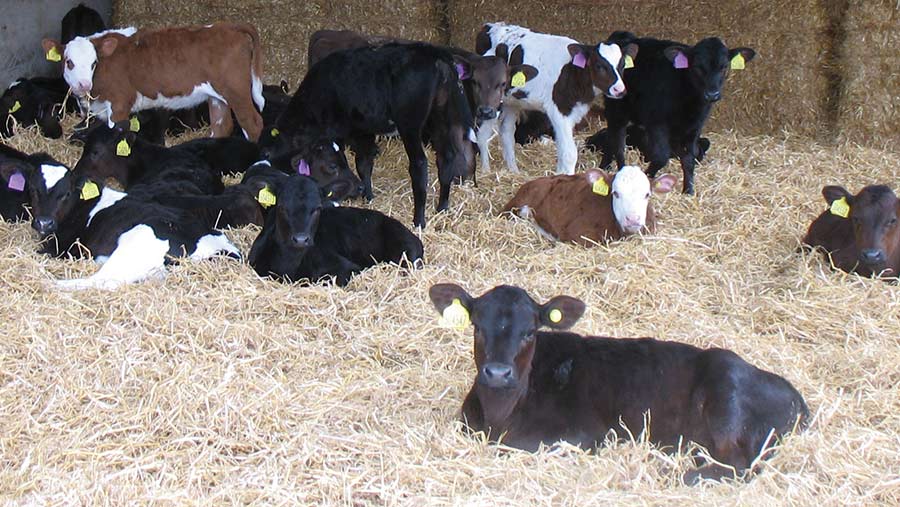Dairy crossbred beef targets £700 gross margin
 © MAG/Shirley Macmillan
© MAG/Shirley Macmillan A low-cost, grass-based beef rearing operation is turning a profit from dairy cross-bred calves and giving farmer Graham Parks an enjoyable lifestyle.
He buys 300 calves a year from two spring-block calving herds, finishing at 24-32 months, and forecasts a gross margin of £700 a head slaughtered this year.
See also: How to finish beef calves from block-calving dairy herds
His system is based on simplicity, rotational grazing, baled silage, and minimal concentrate input, at Overbank Farm near Macclesfield, Cheshire. This means 850 cattle can be run by Graham most of the time.
Help is employed for the “two-man” jobs, which works out at one person, one day a week, for 40 weeks, plus assistance from his partner, Pam Clarke.
“I need three things: electric fencing, water troughs in every field – I don’t need tracks – and 1t lime every other year, according to soil tests. [Lime] helps grow grass and makes better use of your fertiliser,” he says.
Cost savings
Graham set up his farm to reduce feed costs by growing good-quality grass and grazing it efficiently. Every field can be split with electric fencing according to stocking rates, each one has a water trough, and every field is grazed in rotation.
Big-bale silage is only made from a surplus, with a small amount clamped for heifers on a self-feeding system over winter.
Farm facts – Overbank Farm, near Macclesfield
- Grazing platform: 129ha (320 acres)
- Grow 14-15t dry matter/year
- Stocking rate: 0.8 livestock unit (LSU)/ha for cattle over 2 years old; 0.64LSU/ha at 1 year and 0.35LSU/ha for calves
- Sandy loam soils
- 146m above sea level
- Average annual rainfall 990mm
- Carcass gradings: 90% O+4L, a few H grades, some R grades
Last year, Graham fed just 475kg a head of concentrate over the animal’s lifetime. Grass, at 12.5-13MJ/kg dry matter (DM) metabolisable energy (ME) all summer, is “top quality”, he says.
Turnout starts in mid-February, with all stock out by 7 March, while housing is not until late November. The rotation operates a leader-follower system on a 23-day round, using the different age groups of cattle.
“It costs me £600/day to feed them on bales inside; once they are out grazing, I save £400/day,” he says.
Some fields in environmental stewardship get no fertiliser and are left ungrazed for five months over winter. Muck is spread on paddocks that are shut up for silage.
Otherwise, the farm gets 200-250kg nitrogen (N)/ha a year as four split applications of liquid N between mid-March and the last week of August, applying phosphorus, potassium and sulphur as well.
Sourcing calves
Having had poor results from calves bought at auction, Graham now buys direct. Most are by Angus and Hereford bulls out of Jersey cross-breds that would be considered of low value owing to their genetics.
“A lot of calves are 30kg on arrival and average 35kg. The calf is a by-product from easy-calving sires. I have no influence on the bulls used, although I probably should look at it [and its effect on my system].
“I can’t say any one breed does better than the other. They are all from grazing herds and do well off grass; some Blue bullocks need a bit extra concentrate to finish,” he says.
Graham knows the calves have had sufficient, good-quality colostrum, are trained to the teat, and have grazing genetics. This is critical for success, he says, adding that the milk feeding period sets calves up and prevents problems later.

© MAG/Shirley Macmillan
“For the first 10 weeks I’m feeding them twice a day and I’m observing them so can spot any issues quickly; when they go out to grass, I can go on holiday.
“We’ve had 2.6% mortality this year, which is a bit disappointing as it’s usually lower, but it’s a lot lower than calves bought out of the auction.”
Graham collects calves aged seven to 14 days to make two groups of 90, with a seven-to-eight-week age spread. They are treated with an intranasal pneumonia vaccine, disbudded and rubber ringed on arrival.
He feeds them twice a day on a teat feeder in the passage, beds up and feeds concentrates, taking about 20 minutes for each pen.
After four weeks, milk is dropped to once a day for two weeks, then weaning takes place once calves are eating 1kg a head a day of cake.
Grazing management
Turnout is into an “easy” field beside the buildings with plenty of shelter and banks. Grass covers will be just under 2,500kg DM/ha to encourage intakes, with straw available in a ring feeder.
For the first two weeks, 1kg a head of beef nuts is fed daily through a snacker. After six weeks, concentrates drop to 0.5kg a head for the rest of the summer.
Calves are wormed according to worm counts and treated for fluke and flies. Heifers are reared on 17ha (41 acres) about two miles away from the farm, with some returning in August as stocking rates lower.
A group of 180 calves grazes one to two days ahead of finishing cattle until August.
Older animals take the residual down to 1,500kg DM/ha, which is crucial for good-quality regrowth and keeping pastures weed-free. The remaining 120 calves graze ahead of finishing heifers.
On the first two grazing rounds, bullocks are moved daily using a front and back fence, with a third fence set up for the next day. This means if conditions are wet, cattle can be moved straight away to avoid poaching.
“We had a very wet March and suffered a bit [with poaching],” says Graham. “The rest of the summer, we move breaks every two to three days.
“At the end of October, the smallest 40 calves on weight get 1kg of concentrates, the next smallest 0.5kg and the biggest 60 heifers go onto big bales.
“Ninety bullocks are outwintered on grass and bales without concentrates. Heifers are kept on self-feed silage and cubicles across the road.”
Concentrates are fed to finishing animals from 1 June at 2kg a head a day to bullocks, increasing 1kg a month up to 4kg; heifers receive 1kg a head a day.
Finished cattle are sold to Dunbia, and to Honest Burgers in London, which is paying a 10% premium for grass-fed steaks with marbling.
“For the past five years, I’ve started selling in August and cattle size gets bigger every year. Heifers started going in April this year.
“The average age at slaughter is 27 months, and they can go to 30 months. Bullocks average 330kg deadweight and heifers at 270-280kg,” he says.
Overbank Farm was the venue for a spring farm walk organised by the British Grassland Society, agri-tech company LIC and AHDB
